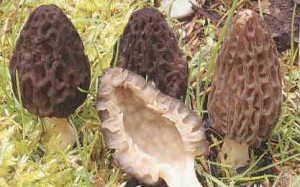Spring mushrooms, wow!
Edible spring mushrooms are considered morels and stitches. The first mushrooms appear already in early April on thawed patches warmed by the sun. They acquire a full, pleasant taste only in May. In the markets in Rybinsk, morels have already begun to be sold.
Morel line strife
Any morel differs from a line in shape: in morels, the hat is ovoid, elongated, often similar to a cone; the lines have an irregular spherical shape, as if a sheet of paper has been crumpled, their shape resembles a brain or a walnut.
This is what morels look like

This is what the lines look like


Table: what is the difference between a morel and a line
| Morel: conical, tall, edible | Line: regular, giant | |
| Hat coloring | yellow-brown, black-brown brown or dirty brown, grayish-black, ocher-yellow, gray, brown, olive-brown, black-brown | brown, dark brown shade, yellowish or yellowish-ocher, yellowish-brown, reddish-brown, the color strongly depends on the place and growing conditions |
| cap surface | strongly protruding folds or ribs, honeycomb-like cells | the cap is folded, has numerous convolutions, is divided into many lobes, its surface looks velvety |
| hat shape | narrow, conical or ovoid, ovoid-rounded, less often flattened-spherical | irregularly rounded, reminiscent of a brain or a walnut. |
| Leg | cylindrical, slightly thickened at the base, hollow inside (constitutes a single cavity with a cap), brittle, whitish, but darkens with age, becoming yellowish, creamy, brown | the edges of the cap are connected to the stem, which is usually irregular in shape, short, wrinkled, furrowed-folded, often immersed in the soil, inside - hollow, whitish, quite often completely hidden by the cap, sometimes has a yellowish-pinkish tint |
| Mushroom inside | hollow | hollow |
How to eat morels and lines?
In reference books we find the following information: morels and lines are considered conditionally edible mushrooms. What does it mean? The lines contain a special toxin, gyromitrin, which is poisonous in fresh mushrooms. There are no reliable data on the toxicity of morels, but given the fact that morels and lines are often confused or collected in one basket (and gyromitrin is volatile), both types of sanitary doctors in Russia are considered as "conditionally edible" (Wikipedia).
With prolonged cooking, however, their pulp of the fungus toxin passes into a decoction, and when dried in the open air, it evaporates. Before cooking, mushrooms are recommended to be soaked in cold water, as forest debris and insects often get stuck between the folds. Sliced mushrooms must be boiled for 30 minutes, drain the water, rinse the mushrooms thoroughly. Another way: boil mushrooms for 15 minutes, drain the first water, pour water again, cook for another 15 minutes, rinse. It is strictly forbidden to eat the broth in which these mushrooms were boiled or cook soups with them.
Boiled mushrooms are put in a pan, fried. At the end of frying, add a couple of tablespoons of sour cream, stew for 5 minutes. Served with potatoes or buckwheat.
Experienced mushroom pickers collect both lines and morels. The real morel, the conical morel, the high morel, the ordinary line and the giant line are suitable for food. For taste, many mushroom pickers prefer lines (giant), believing that morels are less tasty.
But it is the lines that should be eaten with caution! For some people (especially children) with weak digestive systems, even a small amount of toxin can be dangerous.
Where do morels and lines grow?
Lines live on burnt, sandy soils. They can be found under coniferous trees, in deciduous and birch-mixed forests, often near birches or old stumps lying on the ground, on forest edges and other well-heated places. Lines often grow in rather large groups.
Morels often grow in coniferous or mixed forests, on well-lit edges and clearings, in gardens and parks, growing in clusters or singly. Favorite places: floodplain forests, aspen forests, alder deadwood, as well as places where the soil is damaged: roadsides, slopes of ditches and ravines, campfires, ruins, etc. Grows well near ash trees. Morels also prefer light deciduous forests, grassy, protected places: lawns and forest edges, under bushes, in clearings and clearings, near fallen trees, along ditches and along the banks of streams.
Morel high is rare and in small numbers. It grows on soil in coniferous and deciduous forests, often in grassy glades and edges, in gardens and orchards. Lives in the mountains.
Our experiment
Armed with theoretical knowledge, on May 13 they decided to conduct an experiment and for the first time went into the forest in search of spring mushrooms: morels and lines. We looked for them where we usually collect white, boletus and boletus in abundance in the summer. An hour and a half search, alas, turned out to be fruitless.
But while walking through the forest, they discovered a forest monster, ...

... young shoots of lilies of the valley, ...

... we enjoyed the rustle of leaves and lovely forest landscapes to our heart's content.



From the forest they brought only pollen on boots and a lot of impressions!

Nature is blooming, and the summer mushroom season with noble white, boletus, chanterelles is just around the corner!
Do you pick spring mushrooms?




